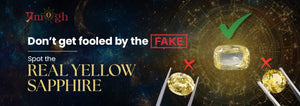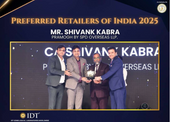The yellow sheen of a Yellow Sapphire, or Pukhraj stone, is not only beautiful to behold, but it is also particularly desirable for its metaphysical and astrological properties. As Jupiter's stone, the celestial Guru, a natural Yellow Sapphire, is said to find fortune, wisdom, and wedded happiness. The worth and power of a Pukhraj stone come from its natural origin.
But since the demand for this valuable gemstone is on the increase, the market is filled with imitations, from low-quality and heated specimens to entirely lab-grown artificial stones. Identifying a real Yellow Sapphire from a fake one is a challenging exercise, more so for an inexperienced eye. This guide will help you with knowledge and give you practical advice on how to recognize an authentic Pukhraj stone.
The Truth About Fake Yellow Sapphires
Though a genuine Yellow Sapphire is a corundum mineral, a counterfeit Sapphire can be a coloured glass, a heat-treated quartz, or a synthesized laboratory stone. Such reproductions can look identical to a natural stone in terms of colour and lustre, but do not contain the inherent qualities that make the original stone effective. Hence, knowing how to spot a genuine Pukhraj is an important prerequisite to buying one.
5 Easy Ways to Identify an Original Pukhraj Stone

In order to make sure that you are investing in a genuine gemstone that possesses real value and astrological strength, it is very important to understand how to distinguish a natural Pukhraj from a fake one.
Below are the five effective ways through which you can identify whether your Pukhraj stone is real or not.
1. The Visual Test: What to See with the Naked Eye
Even without a magnifying glass, you can look for a couple of signs to assist you in your first observation of a Pukhraj stone.
Colour and Clarity
A real Sapphire will have a uniform and consistent colour across the stone. The colour can also vary from lemon yellow to deep golden yellow, but must never be patchy or display distinct colour zones.
The clarity of the stone is the most important factor. However, a perfectly flawless stone is extremely costly and rare, which is mostly a warning sign of a lab-created Sapphire. A true Sapphire will have tiny flaws, which are natural and intrinsic to the stone.
Lustre and Refraction
An authentic Yellow Sapphire possesses a high refractive index, thanks to which it sparkles and reflects light brilliantly. If you place the stone in a light source, the stone should yield a forceful, sharp flash. Imitation Sapphires, particularly glass-made ones, will exhibit a lesser or a glassier lustre.
A natural Pukhraj stone also has a special feature known as dichroism, wherein it exhibits two varying colours when light is reflected from different directions. It is a delicate but significant sign of a natural gemstone. Also, with the help of a detailed buying guide, you can select the real Pukhraj stone.
2. The Touch and Feel Test: The Hardness
As for hardness, the actual Sapphire is among the hardest minerals on our planet, surpassed only by a diamond, with a Mohs hardness value of 9. This makes it extremely resistant to scratches and extremely hard.
One easy test you can conduct is to rub the gemstone lightly against a hard surface. If the gemstone scrapes the surface and doesn't get scratched itself, then it is probably an authentic Sapphire. But beware, as this technique should be applied with extreme care, for it can harm a softer imitation gemstone.
3. The Bubble Test: A Clear Indicator of Fakes
This is one of the most authentic and straightforward tests to identify a fake Sapphire, especially one made of glass. Using a magnifying glass or a jeweller's loupe, inspect the inside of the stone carefully. A Pukhraj using glass or some other artificial medium will usually have tiny air bubbles present. They might be round or oval and are a definite indicator that the gemstone is not natural.
A real Pukhraj ratna, however, can also have natural inclusions but never in the form of perfectly round air bubbles. Natural inclusions in a gemstone are usually in the shape of fine silky threads, minute crystals, or deposits of minerals.
4. The Specific Gravity and Weight Test
A natural Yellow Sapphire possesses a specific gravity of around 4.00, which implies that it is heavier than imitation materials. If you possess an accurate jeweller's scale, you can compare the weight of your gemstone with the weight of an established genuine Sapphire of the same dimensions. A counterfeit Yellow Sapphire that is made of glass or other man-made materials will weigh less than an authentic Pukhraj gemstone of the same size.
Take Note: This test involves a measure of knowledge, but it cannot be the definitive means of distinguishing between an authentic and a counterfeit gemstone.
5. The Laboratory Test: The Most Reliable Method
In any uncertainty, the most absolute means of identifying the genuineness of a Pukhraj stone is to have it certified by a genuine gemological laboratory. These laboratories possess the equipment and expertise to perform a series of tests, including refractometer measurements, specific gravity testing, and microscopic study of the inclusions in the gemstone.
A lab report will give you all the important details regarding the gemstone, such as whether the gemstone is natural or synthetic, its color, its clarity, and whether it has undergone any treatments (for instance, heat treatment).
Word of Caution: It must be noted that not all natural Sapphires are equal. Most of the Sapphires available in the market are heat-treated for colour and clarity improvement. Although the gemstones remain natural, the heat treatment process may lower their astrological energy.
Final Thoughts
Identifying a real and a fake Pukhraj gemstone is a skill that comes with knowledge and practice. By closely observing the gemstone's physical properties, that is, the colour, clarity, lustre, and hardness, you will be able to make a better decision. The best way is always to have the gemstone certified by a professional gem laboratory.
Purchasing a natural, authentic Yellow Sapphire is an investment in your health, and taking the time to verify its authenticity is one step you should take. When you buy a Pukhraj gemstone, always go to a reputable and reliable seller who will offer you a valid certificate of authenticity and an open return policy.
FAQs
What is the biggest difference between a natural and a man-made Yellow Sapphire?
The primary difference is where they come from and what they are made of. A natural Yellow Sapphire is a true gemstone that takes millions of years to grow in the Earth's crust. A synthetic or laboratory-created Sapphire is a human-made gemstone, manufactured in a lab, duplicating the chemical and physical makeup of a natural stone. Although a synthetic Sapphire will appear identical, it does not have the different inclusions, astrological vibration, and worth of a natural stone.
Are all natural Yellow Sapphires costly?
The cost of a natural Yellow Sapphire may greatly differ based on a number of factors, such as its carat weight, colour, clarity, and place of origin. Natural, untreated gemstones with a rich colour and good clarity will cost the most. Thinner gemstones or those that have minor inclusions may be more budget-friendly. The idea is to strike a balance between a good gemstone and your price range, making it a natural and original piece.
Can a heat-treated Yellow Sapphire still be considered real?
Yes, a heat-treated Sapphire qualifies as a real, natural gemstone. Heat treatment is a standard and accepted procedure in the gem trade to improve the colour and clarity of a gemstone. But an untreated gemstone with a high-quality natural colour is usually more valuable and astrologically effective. A trustworthy dealer must always indicate whether or not a gemstone has been treated and will share the gem certificate.
What are some common materials used to create fake Pukhraj stones?
The replicate Pukhraj stones usually consist of glass, coloured quartz, or an artificial yellow spinel. These have been selected, as the same could be artificially altered to take the form of the colour and brilliance of a natural Sapphire. They do not, however, possess the hardness, density, and specific light-refracting characteristics of a natural gemstone. A basic visual examination under a loupe or magnifying glass is normally capable of exposing air bubbles in a glass-filled imitation.
Is the "bubble test" an index of a counterfeit Pukhraj?
The bubble test is a very effective way to detect glass-filled imitation Sapphires. One can readily see neatly round, enclosed air bubbles inside the stone, which unmistakably indicates a man-made substance. However, this test is not always successful with all kinds of Sapphires, like lab-grown synthetics.
Why is a gemological certificate necessary when purchasing a Pukhraj stone?
A certificate issued by a well-established lab is the best evidence of the authenticity of a stone. It offers you an impartial and expert examination of the stone's features, such as whether it is natural or man-made, its weight in carats, colour, clarity, and whether it has been treated. A certificate makes you sure about your purchase and saves you from purchasing a forged or misrepresented stone.
Can I test the hardness of a Pukhraj stone at home?
Although an original Pukhraj stone is extremely hard, with a 9 on the Mohs scale. It is not advisable to determine its hardness at home by scratching it against other objects. A natural Sapphire stone will not scratch, but an imitation one may be harmed during the test. The most secure and reliable method to establish a stone's hardness and other features is by a professional gemological laboratory.



















































